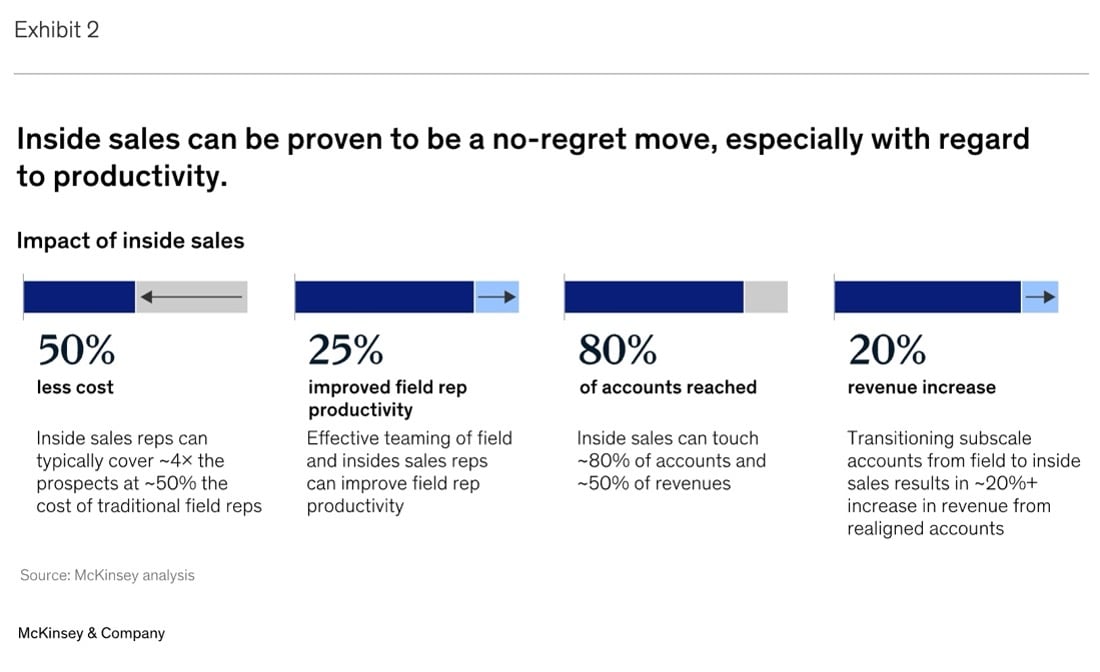Growing customer demand for seamless and transparent services has driven drastic changes in B2B sales in recent years. In response, whether you outsource your B2B sales or manage them in-house, you’ve likely been forced to re-examine the structure of your sales organization. Traditional sales models and strategies have long proved to be the norm, and while outside sales have driven the success of many companies, today’s environment demands an innovative, agile approach to sales teams.
Stepping out of the Sales Comfort Zone
It’s easy to think of inside sales vs. outside sales as contrasting strategies. Salespeople even tend to categorize themselves as one or the other. Of the 5.7 million sales professionals in the U.S., approximately 52.8% are outside sales reps, while 47.2% are inside sales reps. As you decide which model is optimal for you, know that McKinsey finds top performing B2B companies are 50 percent more likely to leverage inside sales.
Increasingly, inside sales has become a dominant sales strategy for B2B, SaaS, and even B2C organizations. Inside sales reps can work remotely, whether in an office or from home, generating leads, nurturing prospects and converting them to customers, improving productivity along the way. In fact, says McKinsey, inside sales reps can typically cover four times the prospects at 50 percent of the cost of a traditional field rep, allowing the team to serve many customers without sacrificing quality of service.
Best-in-class B2B sellers have achieved up to 20 percent revenue gains by redefining go-to-market through inside and hybrid sales. Source: McKinsey & Co.
Inside sales reps spend most of their time connecting with clients by phone, email, or video conferencing. They’re the in-office salespeople, while their counterparts sell face-to-face. This positions inside sales teams well to cover 80 percent of a company’s accounts—often smaller and medium-sized customers—which account for about half of revenues.

The ratio of inside-to-outside sales reps continues to narrow. In 2017, 43.5% of sales reps were inside sellers, but the trend appears to be moving toward an even balance. While some companies in the U.S. report that 50/50 balance is the ideal, many are moving away from the inside-outside binary and toward a hybrid model. McKinsey found that some 85 percent of companies expect hybrid sales will be the most common job role within three years.
Hybrid sales professionals spend some of their time in the office on inside sales, but they also drive or fly to client sites and do some selling in-person. One digital marketing agency, Workshop Digital, has an entirely hybrid team. Reps close about 80% of deals over the phone or web but go out to meet with local and high-value clients in the style of outside sales.
Hybrid can be ideal for bigger accounts, says McKinsey, because:
- It’s flexible and can rely on a combination of channels, serving customers where they prefer to buy
- It is scalable, thanks to the use of remote and online sales
- It’s effective because of the multiplier effect of numerous potential interactions
Looking at Inside Sales
Inside sales reps must:
- Possess product knowledge to assist with customer service and deliver accurate brand awareness
- Foster relationships with prospects while establishing an ongoing rapport and building trust
- Nurture prospects through the sales process, with the goal of converting them to customers always in mind
- Meet quotas, close deals, and report important sales data
Because inside salespeople deal mostly with smaller-ticket transactions, they tend to convert leads faster and can close more deals in a short time. Compared to organizations with more outside sales reps, those with more inside sales reps:

Unlike outside salespeople who work mostly on their own with clients, inside salespeople must be able to function well as part of a team. They need to balance their own goals with team goals and be willing to adapt their workload accordingly.
Inside salespeople also need to be able to switch quickly from one lead to the next, knowing that no two leads will be at the same place in the buying journey. One might be just starting to evaluate options, while another might be ready to buy that day. Most inside salespeople have multiple leads in their pipeline at any given time, so they must switch their approach many times throughout the day.
Comparing Inside Sales vs. Outside Sales
In the long run, companies pay more for an outside sales rep than for an inside sales rep. Indeed estimates the average salary of an outside sales rep is $79,487, with commissions averaging $22,560. Inside sales reps make a more modest salary of $58,527 with commissions averaging $12,000.
Having more outside sales reps will cost your company more, and not just because of the difference in salary. The work of outside sales reps involves travel expenses—flights, car rentals, hotels, client dinners, and more.
Outside sales reps tend to work with one client at a time. It’s an effective model but a difficult one to scale. If you suddenly have a large influx of high CLV clients, you’ll probably have to hire more outside reps. There’s just no way to easily add more potential clients to an outside rep’s busy schedule.
Inside sales teams scale much more easily. Because they communicate with leads remotely, you can add more to their plate without much difficulty.
Outside sales reps are expected to be extremely independent and self-motivated. Because these reps usually work offsite, they have to get things done with minimal support and direction. If a client isn’t in the office, or the company car breaks down, or there are changes to flight schedules, the outside sales rep has to make sure the sale happens anyway.
Outside sellers also have to be able to dive deeply into each business relationship. They need to focus on each client, get to know the client’s pain points, and understand exactly how to position the product as the right solution.
If you tend to add and qualify new leads quickly, and if your leads convert in a matter of weeks rather than months, an inside sales team is your most scalable option. You just need to have enough hybrid or outside salespeople so if you do get a high-value lead that needs more attention, you can accommodate without completely restructuring your team.
Scalability is why many teams are turning to hybrid models. It can be hard to predict which potential clients will need the attention of an outside sales rep and which will be able to close the deal remotely. If you have people who can shift from inside to outside sales as client needs dictate, you don’t have to pay the high salary of an outside sales rep when you don’t need them on outside sales full-time.
Striking a Balance
Very few companies can function with a sales team that’s made up of entirely inside or outside sales reps. The question is how to divide your team to best use your resources.
Outside sales and inside sales rely on many of the same tools, so as the lines continue to blur between the two, it’s drifting away from comparing the two, but becoming a question of what can be done to successfully marry the utilization of both functions?
Consider the Client
Think about the kind of people you sell to. Will they want to have face time with a rep in the field, or will they be just as happy talking to an inside sales rep over video chat?
Some companies have tech-savvy decision-makers that do just as well online as in person. Sometimes they even prefer to close entire deals online, so they can research your product on their own time and not feel rushed into a decision.
Consider Your Product
Do you sell the kind of product that needs to be demonstrated and shown off in person? Is it a specialized product that needs to be explained face-to-face? If so, you need to have more outside reps available. If not, you may choose to have only a few hybrid reps that can step in for outside sales when needed.
Consider Your Training
You also want to think about your product in relation to your sales team. There are companies out there that sell highly specialized medical equipment or tech. Some companies even have multiple specialized products that need intensively trained salespeople to pitch them.
The more specialized your product, the more you’ll want to have dedicated inside and outside salespeople. Train each person for their role in depth and assume they’ll be focused on that task and that product.
If your product is less specialized, consider a hybrid model. Hire people to be both inside and outside sales reps, and assign people based on their talents. Monitor each person’s performance and train according to where you need people, whether it’s inside or out.
Ready to talk?
If you’re unsure which model is right for you, consider sales outsourcing. We’ll build a team that will blow your doors off.


